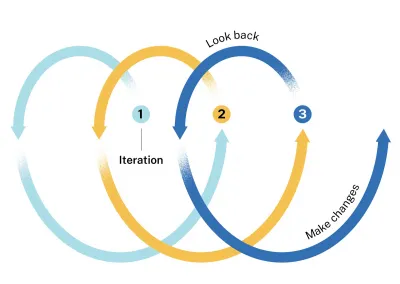
Iteration
Everyone iterates at different points
Iteration refers to making a series of design versions. This is a classic design practice; its purpose is to push designers past the first expression of ideas to build them out, identify their advantages and drawbacks, and revise ideas before prototyping begins.

Most people, in any profession, iterate constantly; they just define the iterations they’re making in terms of their immediate outputs, whether those are emails or processes or methods, instead of their strategic goals. In design iteration, teams use iterations as a way to approach the strategic goals of the project, as well as fulfill their immediate goals.
To understand iteration at the immediate, daily level, think about emails. Any email that requires a bit of thought, whether it’s for work or a personal matter, requires iteration. When we write thoughtful emails, we think about what to say. We try out wording, delete words, and move things around until we think we have expressed in the best way what we want to say. Then we send it. All those different email versions were iterations of the email. They weren’t the email’s final form; they weren’t even the second or the third. There were many versions that had to be made in order to reach a version that seemed to be the most clear, the best way to say what needed to be said.
Turning insights & opportunities into design iterations
Designs must emerge from discovery. You may recognize this process diagram from the designed things section of this guide. It shows how each opportunity can be developed into multiple iterations.

The tangrams in the fields of opportunity are stand-ins for an iterative design process. Why tangrams? Because a tangram puzzle is a useful way to talk about the cycle of ideation and iteration during the design phase. Every tangram consists of the same seven shapes, called tans.

To solve a tangram puzzle, a player looks at an outline of a tangram shape and re-creates the shape using all seven shapes, or tans, with no alterations and no overlaps permitted. Each different tangram is representative of a new iteration within a field of opportunity cone. And, like design iterations, each tangram takes on similar, though not identical, shapes.
This is similar to how the design team puts together pieces identified in the discovery phase; pieces that, through ideation and iteration, become a new product, service, or system.

Coming up with only one design option will almost never produce the best solution. That’s akin to walking into a supermarket and buying the first apple you see because it’s an apple and you need an apple. You don’t do that. You examine several apples, considering their size, sweetness, and defects in light of what you need before making the final decision.
It is the same with design solutions. You work with many possible solutions to arrive at a selection that best suits the needs of your participants. All your iterations are related to each other, but none is identical. Instead, they build on one another, just as all tangrams are built from the same seven shapes into an infinite variety of finished creations.
Additionally, like the constraining rules of the tangram puzzle game—only the seven tans, no alterations, and no overlaps—there are many times your solutions will need to address or operate inside some strict constraints dictated by factors like time, costs, and climate.
Sometimes, this process can seem daunting or even pointless, but, as in the synthesis portion of the discovery phase, you will find that the more you and your team work with the ideas for design, the more possibilities you will see.

